
We had been to Jodhpur and Jaisamler from the 4th to the 11th of July’08. With the weather forecast predicting rains and thunder showers we were a little apprehensive about the trip. Fortunately the week was full of sunshine and fun and thanks to the overcast skies we did not have to face the much talked about Rajasthan heat.
We reached Jodhpur by train on 5th morning and went straight to Hotel Ajit Bhavan Palace.
The Ajit Bhawan Hotel of Jodhpur stands as a retreat of warm Rajput charm and hospitality. Constructed exclusively for Maharaja Sir Ajit Singh of the former Jodhpur state, Ajit Bhawan is vividly alive with the hospitality extended by the family of late Maharaja who still stay here. One of the premium Heritage Hotels in Jodhpur, Ajit Bhavan Hotel in Jodhpur offers a blend of old world elegance with the contemporary comforts. Our room had been booked through RCI and was very warm and comfortable.



Some travel sites had mentioned that the place was rat infested etc, which really had me worried, but either those remarks have been put up by some competitors or there has been some dramatic change since the people went there.
The next morning at around 10:00 we were off to see the sights of the city. The first place we went was Jaswant Thada. It lies to the left of the Mehrangarh Fort complex. It is a 19th century royal cenotaph built in commemoration of Maharaja Jaswant Singh II, the 33rd Rathore ruler of Jodhpur. The son of Maharaja Jaswant Singh, Maharaja Sardar Singh, in the memory of his father, built the Jaswant Thada. The cenotaph has two more tombs within it. Near to this are the royal crematorium and three other cenotaphs.





It is an example of architectural brilliance in India. It is a white marble memorial, built out of intricately carved sheets of marble. The carving shows the genius of the sculptors. These stones are extremely thin and polished. As a result, the outside surface of the monument emits a warm glow when the sunrays fall on its surface. There is also beautiful marble jali work on the cenotaph. You can have some nice views from the terrace in front of the cenotaph. The cenotaph of Maharaja Jaswant Singh displays portraits of the rulers and Maharajas of Jodhpur. The main memorial has been built like a temple. To visit the Thada you have to go through the rocky hills. This also lends a mystic aura to the whole visit.
From there we moved on to the Mehrangarh fort, which is one of the largest forts in India. It is also the most magnificent fort in Jodhpur. The beauty and the grandeur of numerous places in the fort narrate a saga of hard sandstones yielding to the chisels of skilled Jodhpur sculptures. Mehrangarh literally means "Majestic Fort". The fort is amongst the popular tourist places in India. It is situated on a 150 m high hill. It was founded by Rao Jodha in 1459. The Mehrangarh Fort can be reached from the city 5 Kms below, through a circular road
The fort is situated at an altitude of about 125 metres and is spread over an area of 5 sq km, with seven gates. These seven gates have to be crossed to reach the fort. The gates still bear the marks of the various battles fought in the bygone era. Its second gate still stands witness to canon ball hits by attacking armies of Jaipur during wars. One of the gates is Jayapol, meaning victory. It was built by Maharaja Man Singh to commemorate his victories over Jaipur and Bikaner armies. Another gate, Fattehpol, again meaning victory, was built by Maharaja Ajit Singh ad a celebration for the defeating the Mughals.



Other attractions of Mehrangarh Fort, Rajasthan include several palaces inside the fort, with their sprawling and huge courtyards. One of the fort's palaces, The Moti Mahal or the Pearl Palace, has the royal throne of Jodhpur, the Sringar Chowki. The fort also has galleries, temples, etc. To the left of the Mehrangarh Fort is the Chhatri of a soldier, Kirat Singh Soda. It is the spot where he fell while defending the fort against the armies of Amber.



The palaces in this fort were built in an informal pattern over several centuries. They have their own peculiar style, with narrow staircases, serving as the only means of access to the royal residences within. A collection of musical instruments, palanquins, furniture and cannons on the fort's ramparts are well - preserved.
The Mehrangarh Fort, with its beauty, is the living proof of the hard work and skill of the Jodhpuri sculptors.













There is a lot of walking to be done inside the fort and a lot of things to see. An audio guide is available but if you could find a good local guide there is nothing like it. Also carry a lot of water; cause all the walking around is bound to make you thirsty.
We then had a light lunch and headed off to the Clock Tower and Sadar Marketa prime attraction of the city. These colorful markets with tiny shops dotting the narrow lanes are situated in the heart of city and popular for a wide range of handicrafts making then the favorite haunt of shoppers.

Inspite of what your guide or guide book may tell you, it’s best if you are accompanied by a local or you know what you are looking for and are prepared to bargain like crazy. There are some very quaint little shops there, but . . . be prepared to spend a lot of time and bargain to get what you want.
Our next stop was the magnificent Umed Bavan Palace. This immense palace is also known as Chittar Palace because of the local chittar sandstone used. It is the only palace built in 20th century during the famine. It was built as a famine relief project which employment to people for 16 years.

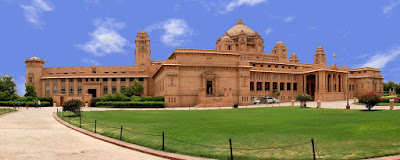
It has its own theatre, eight dining rooms, and a banquet hall which seats three hundred people. A Ball Room had been built, catering to the Westernized royal lifestyle. Much of the interior of the palace is in the art deco style. In fact, it is said to be one of the finest surviving examples of art deco in the world. Deep within the palace is an indoor swimming pool, with a mosaic of zodiac symbols. The palace now runs as a hotel, though, a part of it has been retained as a museum and part as royal residence.
We spent the next 2 days relaxing in the pool and exploring the grounds of the Ajit Bhavan Palace. There are some wonderful vintage cars on display and you can even get to ride in one of them (at a cost of course), but its good fun just spending time on the lawns or lazing around in the pool. They also have a Health Club, Swimming Pool Fitness Centre and a Massage Parlor, which you may like to explore.

The next morning, i.e. 8th July at around 09:30, we left for Jaisalmer by car. Jaisalmer is situated in the western most part of the state of Rajasthan, the heart of the great Thar Desert. Its neighboring Pakistan on its western side. The city Jaisalmer was founded by Bhatti Rajput Rawal Jaisal in 1156. The city used to be a major trade center as it was the trade center as it was the trade route of the western countries to India. The succession of Maharajas of Jaisalmer trace their lineage back to the ruler of Bhatti Rajput Clan Jailasimha. The hilltop offered the safest fort location, dominating and surveying the desert for miles. The Lunar clan of Bhattis is Krishna's descendant, valiant and most feared of the dessert marauders, perennially locked in territorial skirmishes with Jodhpur and Bikaner. One Bhatti scion-Gaj Singh had founded the city of Ghazni in Afghanistan but ultimately lost it to forces from Khorasan. One of his grandsons reclaimed Ghazni, embraced Islam, and came to be called Chagattas (Mughals). They later plundered the land of their ancestors between 1000 and 1025 A.D. Again, led by Babar they came to found the Mughal Empire in India.

Today, tourism will soon rival military bases as the pillar of the city's economy. The military bases hardly impinge at all on the life of the old city and only the occasional sound of war planes landing or taking off in the distance ever disturbs the tranquillity of this desert gem. It's not always been so peaceful, of course, since fortresses have rarely been constructed for aesthetic reasons and medieval desert chieftains were not known for their pacific temperaments. Chivarlic rivalry and ferocity between the various Rajput clans were the order of the day and the Bhatti Rajputs of Jaisalmer were regarded as a formidable force throughout the region. While Jaisalmer largely escaped direct conquest by the muslim rulers of Delhi, it did experience its share of sieges and sackings with the inevitable jauhar being declared in the face of inevitable defeat. There is perhaps no Rajasthani city in which you can more easily conjure up the spirit of those times.
We reached Jaisalmer at around 15:00 and checked into the Fort Rajwada hotel. After relaxing a bit we were off again to see the sand dunes and take a camel back ride into the desert. We went to a place called Sam Sand Dunes. This sandy place is famous for watching sunset and taking a camel ride. Riding on a camel through the desert was a great experience and we saw many rodents and interesting insects along the way. Unfortunately I could not get any pictures of them, as I was too busy trying to stay on the camel. Its gait is a little disconcerting at first, but after around 5 minutes you get used to it and then it is great fun.


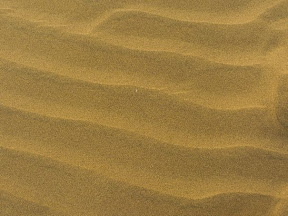

We got back from the sand dunes, which were around 40 kms away at around 20:30 and after a scrumptious meal were totally knocked out. Early the next morning we checked out of the hotel and went sightseeing.
The first place we visited was the Gadisar Lake. The Gadsisar Lake is an artificial water body that stores rainwater – in the harsh desert landscape, it is a major attraction and a favorite picnic spot. The beautiful arched gateway across the road down to the tank is said to have been built by a prostitute.


The story goes that someone poisoned the king’s mind and told him that passing under the gateway would be like passing between the legs of a prostitute. The kind ordered the gateway to be broken down. The lady who built the arched gateway came to know of this and consulted some learned men, who advised her to install a statue of lord Krishna in one of the recesses in the gateway. She did so and the king could not demolish the gateway as he was a follower of Lord Krishna. However till this day, the royals do not use this gateway to approach the lake.
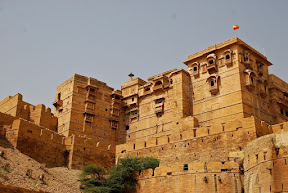
Next was the jaisalmer fort. The Jaisalmer fort was built in 1156 by the Rajput ruler Jaisala. Standing proud to a height of hundred meters over the city with its 99 bastions, the fort is splendid sight in the afternoon sun. Closer, the bastions show up more formidable, vast chunks of honey-coloured stone blocks carved to dovetail together. Within these bastions is a complete township that consists of a palace complex, the havelis of rich Jain merchants carved with an incredibly light touch, & Hindu temples. Placed strategically on the trade route along which ancient caravans passed, Jaisalmer soon became rich, so much so that the merchants, who also served as ministers in the royal courts, came to command more power than the rulers themselves. No wonder the large mansions of the merchants, built adjacent to each other in the nature of medieval desert cultures, are so profusely decorated that eh palace, in comparison, appears to pale. While the havelies & the palace, along with the temples, will warrant the mandatory visits, Jaisalmer is incredible for the experiment it brings alive of a medieval township caught in a time warp, as you move up its cobbled streets. Its incredible sculptors were Muslim craftsmen who were induced, on their journeys to the patrons in other parts of India, to stay. The result is an architectural purity that, because of Jaisalmer's incredible isolation, is not seen elsewhere.
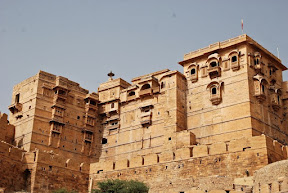
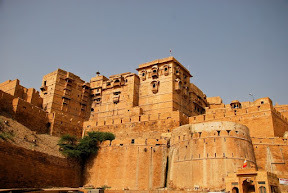
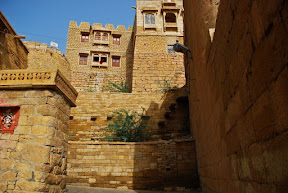
Inside the fort there are many temples and amongst them the Jain Temple is very famous: Being the financers of the Rajputs, the rich and influential Jain community was given full religious liberty; and they built many temples in and around Jaisalmer. The Paraswanath temple is the oldest and the most beautiful of the Jain Temples. The walls of the sanctum are carved with animal and human figures and rising above is a tall Shikhar, which is crowned by an amalak and a waterpot containing a lotus flower.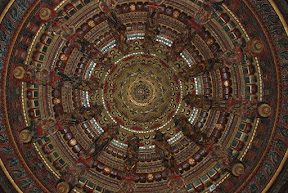






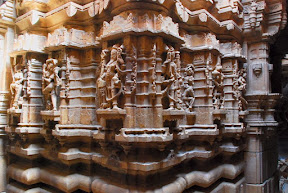
The walk through the fort is around 2 kms, but this being one of the few “public” forts in India, is totally worth it. As of today around 5000 people live inside the walls of the fort.
Hidden deep within a labyrinth of narrow old world lanes with shops, houses and hotels is the Main Chowk (square). This is a great place to shop for silver jewelry, bags and shoes made of camel hide and small gift articles and mementoes.
From Manek Chowk, one can walk into the lanes where the famous carved havelis are to be found. There are also 3 famous havelis here.
Nathmalji ki Haveli: The late 19th century Haveli with intricate architecture a display of sheer craftsmanship. The left and right wings of the mansion were carved by two brothers are not identical but very similar and balanced in design. The interior walls are ornate with splendid iniature paintings.
Patwon ki Haveli: The most elaborate and magnificent of the Jaisalmer havelis. It has exquisitely carved pillars and extensive corridors and chambers. One of the apartments of this five story high Haveli is painted with beautiful murals.
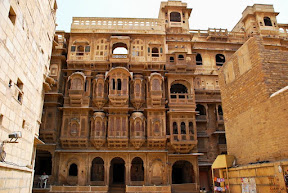
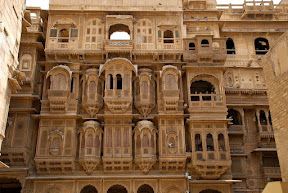
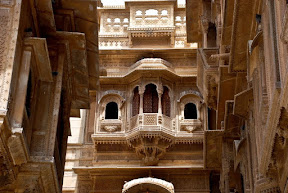

Salim Singh ki Haveli: This 300 years old haveli of Jaisalmer's Prime Minister to Maharaja Rawal Gaj Singh - Salim Singh, has a beautiful blue cupola roof with superbly carved brackets in the form of peacocks. The extraordinary mansion in yellow stone is covered with intricate carvings and has an elaborate projecting balcony on the top storey. The mansion is one of the most notable of the array of havelies.
We headed back for Jodhpur in the afternoon. Just before we reached Jodhpur our driver told us about a massive lake on the outskirts of Jodhpur which provided water to the city. It is interesting to know that Jodhpur receives water from the Himalayas through pipes. The lake was very beautiful with lots of lotus and a variety of birds enjoying themselves in the water.
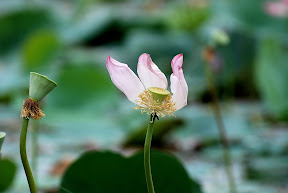
On the 10th we went on a “Village Safari”, which was a 80 odd Km, drive through the villages around Jodhpur. The highlight of this safari was a glimpse into the life of the Bishnoi tribe who over the centuries made a unique blend of ecological sense and religious sensibility their faiths cornerstone.
The Thar desert in India is full of ironies—one of them being the Bishnoi community of Rajasthan. Here, peace is maintained with aggression and robust health rubs shoulders with regular famine. Here penniless women flaunt heavy gold jewelery and wild animals leave the supposed security of jungles to stroll around village huts and farmlands. Not to mention the fact that the Bishnois worship nature in all its manifestations. Not the ripe, yielding nature of ancient pagan societies, but the ruthless and demanding desert where a desolate horizon meets a blazing sky. Here, women suckle motherless deer, die to save trees, go hungry to provide food for animals and live a strictly sattivc life advaocated by their guru Jambaji.
Jambaji, or Jambeshwar Bhagavan, born in 1451 in one of the warrior sects of Rajasthan, was soon disillusioned by communal riots between Muslim invaders and the native Hindus. However, instead of wallowing in despair, he went ahead to form a religion of peace based on 29 (bish: twenty, noi: nine) principles that included compassion for all living beings, cleanliness, devotion, vegetarian diet and truthfulness. Thus, the Bishnois came into being.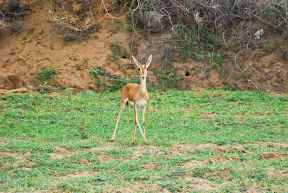
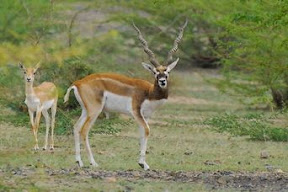
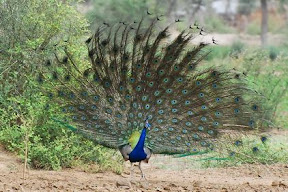

What surprises you as you approach a Bishnoi village is the sheer freedom with which spotted deer, blue bulls, and black bucks race along the roadside or frolic in the open fields. In fact, during our approximately 50 minutes drive from Jodhpur to Guda, we must have seen hundreds of deer and antelopes, roaming around in the fields around us. Living amidst the barren wastelands interspersed with khejri and babool trees, the Bishnois are a proud race. Our guide told us a story about Amrita Devi, a Bishnoi woman who, along with more than 366 other Bishnois, died saving trees. "About 200 years back, Maharaja Abhay Singh of Jodhpur required wood for his palace. So he sent his soldiers to cut trees. Amrita Devi and other villagers hugged the branches while the soldiers chopped them down with the trees. This is still remembered as the great Khejarli sacrifice."
We were also lucky to witness an opium ceremony, of the Bishnoi tribe, a ritual where elders and guests are traditionally welcomed with a mild opium drink. We watched as one of the elders concocted an opium drink by mixing dried opium flowers and jaggery. When ready, each guest was offered a few tablespoons of the drink in right palm to sip.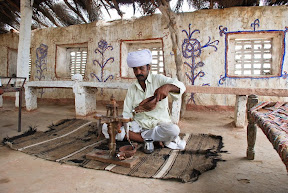
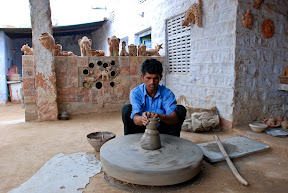
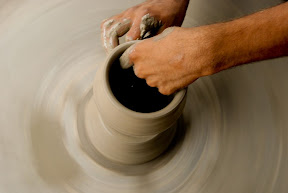


We also visited the houses of a potter, a woman who earned her living by making bed sheets and table cloth using the block printing technique with natural vegetable dyes.
We ended the safari with a visit to a ‘weavers village’ where they still made durries (carpets) with intricate designs in the traditional way, using cotton and camel hair.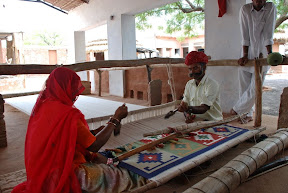
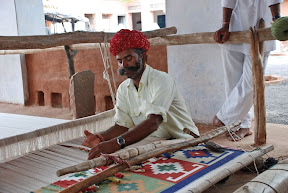
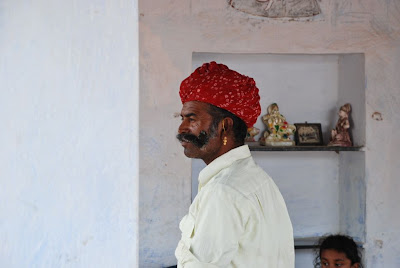
They also served us with an amazing lunch of ‘Bhakri-kadi’ and some vegetable (which I was unable to identify)
After lunch it was time to head back to the hotel and pack for our return to Ahmadabad.



8 comments:
lovely photos !!
so now you are becoming a storyteller along with an excellent photographer
Kewl man...reading this i think i need to make a trip there....great photos
hey umang... absolutely lovely snaps and i surely envy your ability to write so well and fit things in such a nice perspective.... you should carry forward this unique talent further on.........
get into tourist journalism.
nice coverages.
Loved the photos and ur blog!
damn nice pix jiju.... love it...
Thanks. Wonderful watching the blog with your album.
Wow, what a beautiful place . nice blog with all information neeeded ! thank you rajasthan tour packages
Post a Comment